Metro Trains Melbourne
Metro Trains Melbourne, often known simply as Metro, is the operator of services on the electrified suburban passenger rail network in Melbourne, Victoria, Australia. It is the largest suburban rail network in Australia with 17 lines, 219 stations and 405 km (252 mi) of railways and second busiest network in Australia. It is owned by Public Transport Victoria who sublet the infrastructure and rolling stock of Metro Trains Melbourne to a joint venture between Hong Kong-based MTR Corporation (60%), John Holland Group (20%) and UGL Rail (20%).[1] The three constituent companies are also partners in the Metro Trains Sydney joint venture, which has operated the Sydney Metro network since 2019.[2]
 | |
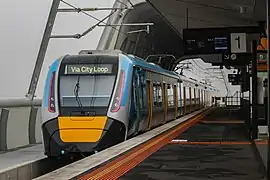 A High Capacity Metro Train departing Carnegie railway station | |
| Overview | |
|---|---|
| Fleet size | 226 six-carriage trains |
| Stations operated | 222 |
| Parent company |
|
| Dates of operation | 30 November 2009– |
| Predecessor | Connex Melbourne |
| Technical | |
| Track gauge | 1,600 mm (5 ft 3 in) Victorian broad gauge |
| Electrification | 1,500 V DC from overhead catenary (except unelectrified Stony Point) |
| Length | 430 km (270 mi) |
| Track length | 998 km (620 mi) |
| Other | |
| Website | metrotrains |
Metro Trains Melbourne operates a fleet of 220 six-car train sets on 965 kilometres (600 mi) of track. There are sixteen regular service rail lines and one special events railway line. Metro Trains Melbourne is also responsible for 219 railway stations and employs a workforce of 3,500 rail professionals including train drivers, mechanical and electrical engineers, network operations specialists and customer service representatives.[3]
The railway track, infrastructure and rolling stock is owned by VicTrack on behalf of the State Government, and is leased to Public Transport Victoria which then sub-leases them to Metro Trains Melbourne. The State Government now also owns the name 'Metro,' and it will likely stay even if there is a change of operators.[4] Metro Trains has faced criticism in the past and was voted the worst rail system in Australia in 2011.[5] However, the operation, punctuality and consistency of the network has greatly improved since 2014 with level crossing removals, target benchmarks for trains and more frequent trains.
History
.jpg.webp)
Metro Trains Melbourne was selected as the new operator by the Government of Victoria through its relevant agency, the Director of Public Transport, in June 2009 and replaced the previous operator, Connex Melbourne, on 30 November 2009.[6][7] It was awarded an eight-year contract with the option of being extended for a further seven years.[8] On 2 April 2012, the newly created Public Transport Victoria took over the management of the contract from the Director of Public Transport.
In May 2012, Australian Rail Tram and Bus Industry Union accused Metro Trains of taking shortcuts in safety procedures, including not checking on-board CCTV and intercoms, and allowing trains with cracked inner glass to take passengers.[9] Metro Trains claim safety equipment is regularly checked during routine maintenance.[9] It was reported in 2013 that tens of thousands of passengers were missing out on compensation when Metro failed to meet monthly performance targets, either because they were not aware of their entitlements or didn't want the hassle of going through a complicated claims system.[10]
On 13 July 2017, Metro experienced a computer outage which resulted in 224 services being cancelled, and 378 services running late. Metro was fined a total of $1.2 million and was forced to reimburse $620,000 to the customers affected.[11] Metro Trains chief Mike Haughton said: "A failure in the core train control system had meant operators could not see the trains, so it was shut down for safety reasons."[12]
In September 2017 the state government extended the contract with Metro Trains until November 2024.[13][14] It was later extended until May 2026.[15]
Rolling stock
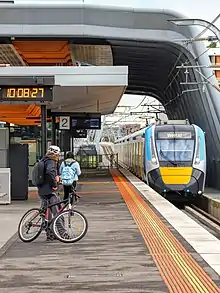
The majority of rolling stock is owned by the Victorian Government business enterprise VicTrack.[16] Metro Trains Melbourne is responsible for maintaining the train fleet. All trains on the Melbourne suburban network are electric, operated by drivers, and fitted with power-operated sliding doors which are closed by the driver, but opened by passengers. The doors of newer model X'Trapolis 100 and Siemens trains are opened by a button, but the Comeng trains are opened using handles. Trains also have inter-car doors to enable passengers to change carriages while in transit. All trains are fitted with air conditioning, closed-circuit cameras, and emergency intercom systems. Trains are fixed into three car units, and may operate alone or in pairs.
As part of the 2008 Victorian Transport Plan, 38 six-car X'Trapolis EMUs were ordered, with the first of 19 trains built by Alstom in Italy arriving at the Newport Workshops on 24 August 2009.[17] The trains were assembled at United Group's Ballarat North Workshops, under a state government requirement for a minimum of 40% local content.[18] Further orders of X'Trapolis saw the fleet total 212 3-car or 106 6-car sets by the time the final sets entered service in 2020.

In September 2016, Evolution Rail (a consortium of Downer Rail, Changchun Railway Vehicles and Plenary Group) was selected to build 65 new High Capacity Metro Trains for delivery from 2019.[19][20][21]
In May 2021, an order of 25 X'Trapolis 2.0 trains was confirmed by the Victorian Government in the lead up to the 2021/22 election. The trains will run first on the Craigieburn, Frankston and Upfield lines and are expected to enter service between 2024 and 2026. These trains have been ordered to allow the retirement of the 40 year old Comeng Trains. In 2022, scrapping began on the oldest of the Comeng Trains after the withdrawal of a series of Comeng Sets. The Pakenham and Cranbourne line is set to be entirely ran by HCMT trains by the end of 2022, followed by the Sunbury line in 2026. With the introduction of X'trapolis 2.0s expected to occur at that time, all Comeng Trains will be retired.
Passenger trains
| Type | Image | Type | Top speed (km/h) | Built | Number | Notes |
|---|---|---|---|---|---|---|
| Comeng | .jpg.webp) |
EMU | 115 | 1981–1988 | 190 3-car sets | Refurbished 2000–2003, second refurbishment 2017–2020[22]
Retirement began in 2017, with the 'chopper' sets being stored at Newport Workshops. By 2022 all the 'Stage 1' life extension tread brake units were scrapped, with the whole fleet expected to be retired by 2030. |
| X'Trapolis 100 | .jpg.webp) |
143 | 2002–2005, 2009–2019 | 212 3-car sets | ||
| Siemens Nexas | 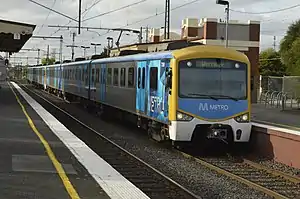 |
145 | 2002–2006 | 72 3-car sets | ||
| HCMT | 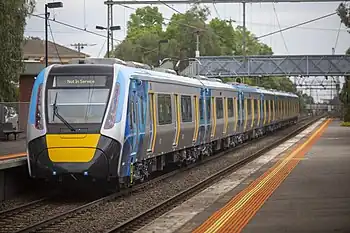 |
130 | 2019– | 70 7-car trains[23] | On order from Evolution Rail for an EIS in 2019 to be used on the Pakenham and Cranbourne lines. The first unit entered service in December 2020. | |
| Sprinter | .jpg.webp) |
DMU | 130 | 1993–1995 | 2 | Leased from V/Line for use on the Stony Point line |
Future Fleet
| Type | Type | Top speed (km/h) | Built | Number | Notes |
|---|---|---|---|---|---|
| X'Trapolis 2.0 | EMU | 130 | 2022–2025 | 25 6-car trains | Ordered 2021. Expected to replace all remaining Comengs |
Maintenance trains
| Type | Image | Type | Top speed (km/h) |
Built | Number | Notes |
|---|---|---|---|---|---|---|
| Diesel electric locomotives |  |
P and T classes | 80 | 1964 | Leased from Southern Shorthaul Railroad for use on maintenance trains | |
| IEV100 | 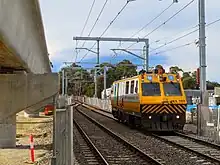 |
Track evaluation vehicle | 80 when recording 100 when not recording |
1 | Built as EM100, recoded to IEV100 in 2013.[24][25] | |
| IEV102 |  |
Overhead inspection carriage | 115 | 1958 | 1 | Built as Harris trailer 679T in 1958, converted to H type carriage MTH 102 in 1984, converted to inspection carriage IEV 102 in 2011 |
| EV120 |  |
Infrastructure evaluation carriage | 115 | 2021 | 1 | Built by Geismar in 2021, to replace IEV100 and IEV102. Can only be hauled by locomotives. |
Former Fleet
| Type | Image | Type | Top speed (km/h) | Built | Number | Notes |
|---|---|---|---|---|---|---|
| Hitachi |  |
EMU | 115 | 1972–1981 | 14 3-car sets | Refurbished 2007. Retired and stored 2013, farewell tour 2014. All sets transferred to Newport Workshops by 2015. Planned to be scrapped some point in the future, except the 6 preserved carriages, although 2 of these are undergoing asbestos testing. |
| B class | 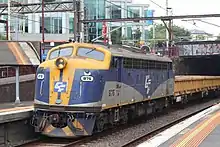 |
Diesel electric locomotive | 1953 | 2 | Returned to CFCL Australia 2017 and MTM subcontracts QUBE to operate the MTM infrastructure upgrade (work) trains contract, B76-80 are used regularly on these trains. |
Classification and configuration
Since shortly after the introduction of suburban electric trains in Melbourne, their carriages have been classified as follows.[26] All fleet types have used these classifications, with different fleet types using different number ranges for the carriages.
- M indicates a motorised carriage, with a driving compartment.
- T indicates a trailer carriage.
- D indicated a trailer carriage with a driving compartment. Only Swing-door, Tait, and Hitachi trains had these.
- G indicated a trailer carriage fitted with both electric and gas lighting, for use on both suburban and country services. Only Tait trains had these.
- BT indicated a second class trailer carriage. Only Swing-door and Harris trains had these. Prior to the abolition of first class suburban travel in 1958, motor carriages were second class and trailer carriages were first class (except for some DogBox carriages).
An exception to the above classifications was the trial double-deck train, which used T to indicate a trailer carriage with a driving compartment, and M to indicate a motorised carriage without a driving compartment.
Currently, all trains except for the HCMT stock are assembled into a symmetrical M-T-M arrangement. Trains comprise either one or two such units. All peak period services and some off-peak services comprise two units. The Hitachi trains, retired in 2014, operated in fixed two-unit sets.
Services and lines
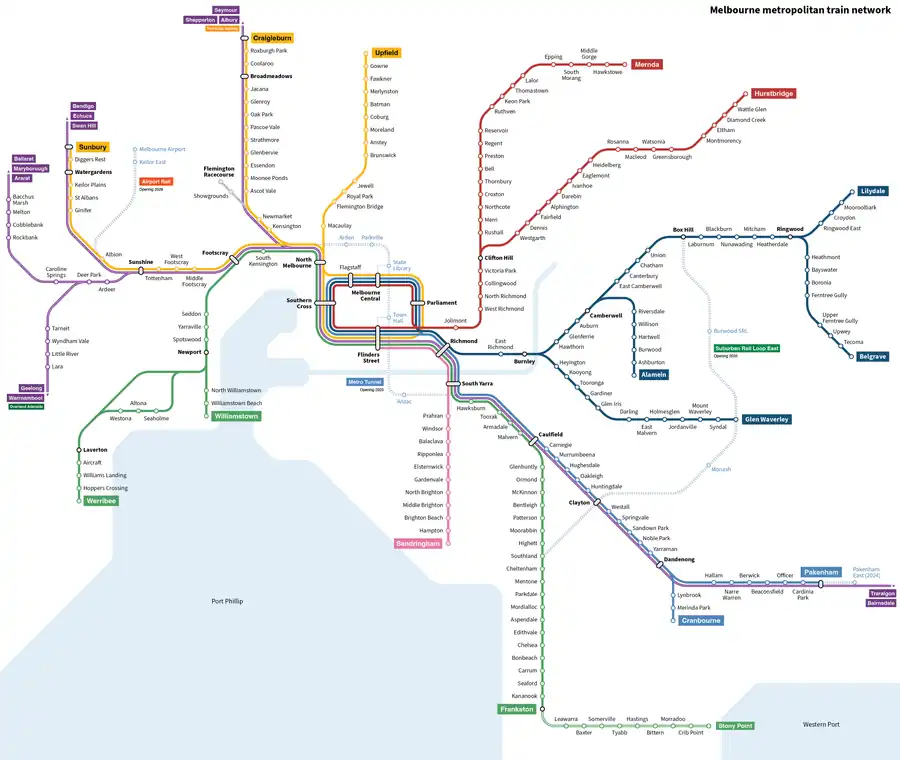
Melbourne uses "clock-face" timetables in off-peak periods, but generally not in peak periods, due to operating near to the capacity of the infrastructure and having to accommodate single-line sections, flat junctions, and regional diesel-hauled trains. Even in off-peak periods, however, frequencies vary according to time of day and day of week, and by line. In some places, services on two lines combine to provide more frequent services on common sections of tracks. Saturday and Sunday services are identical during the day, but differ during the evening on some lines. Sunday morning services however start later than on Saturdays, and run less frequently until around 10am.
Metro Trains Melbourne operates several passenger rail lines and one special events railway line, with travel patterns grouped as follows.
Burnley Group
- Lilydale, Belgrave, Alamein & Glen Waverley Line
Lilydale and Belgrave trains operate via the City Loop, running anticlockwise on weekday mornings, and clockwise on weekday afternoons and weekends. During peak hours, some trains run express in the direction of peak travel using the third track from Box Hill.
Glen Waverley trains run direct to and from Flinders Street on weekday mornings. On weekday afternoons and weekends, Glen Waverley trains operate clockwise via the Loop, with Belgrave and Lilydale services.
Alamein trains operate anticlockwise via the Loop during the weekday morning peak, anticlockwise during weekday afternoon peak and weekends, and operate as 3 carriage shuttles to and from Camberwell during weekday off-peak.
Caulfield Group
- Pakenham & Cranbourne Line
All trains operate via the City Loop in an anti-clockwise direction from Richmond Station and are scheduled to run through the Metro Tunnel in the future to Sunbury.
Clifton Hill Group
- Mernda & Hurstbridge Line
All trains (with the exception of those departing the city after midnight, all services after midnight run direct from Flinders Street) operate via the City Loop (in a clockwise direction from Jolimont station on weekdays and weekends). On most occasions in peak hour, Hurstbridge line trains operate express between Jolimont and Clifton Hill, with the Mernda trains serving the intermediate stations.
Northern Group
- Sunbury, Craigieburn & Upfield Line
All trains operate via the City Loop (in one direction depending on the time of day and day of week), except for the Williamstown services. All off-peak Williamstown services are shuttles to and from the junction at Newport, while in peak they run direct from Flinders Street. Since 9 November 2008, Werribee trains have not run through the Loop during morning and afternoon peaks.
Since 2011, Williamstown services have not used the Northern Loop at all, instead being directed onto the Frankston line as part of the Cross-City group. Werribee trains still used the loop on weekends (apart from Night Network services) until late-January 2021.
Cross-City Group
- Frankston, Werribee & Williamstown Line
Frankston line trains run from Richmond direct to Flinders Street without travelling through the City Loop. The Frankston line train runs through Flinders Street to connect the Werribee and Williamstown line trains removed from the City Loop. All trains operate direct to and from Flinders Street will not travel through the Loop.
During Weekday Peak hour times, the Werribee line train will run express between Laverton and North Melbourne by stopping at Newport and Footscray in under 40 minutes, with Laverton and Williamstown trains serving the stations in between. The Frankston line train runs express between Cheltenham and South Yarra by stopping at Caulfield, city bound trains by stopping at Malvern first, then express to South Yarra.
Stony Point line
- Stony Point Line (non-electrified shuttle beyond Frankston)
Stony Point line services operate as shuttles from Frankston station with passengers to and from Flinders Street required to change trains as there is no electrification beyond Frankston. It is the only non-electrified line operated by Metro Trains, with services being operated using Sprinter diesel multiple units leased from V/Line.
Sandringham line
- Sandringham Line
From 31 January 2021, Sandringham Line services stopped using the City Loop, with all trains operated from Richmond direct to and from Flinders Street 7 days a week.
Special services
- Flemington Racecourse Line (special event service)
There are no regularly scheduled services on the Flemington Racecourse line, but services are run to the Racecourse whenever race meetings are held at the racecourse. Services are operated to the Showgrounds platform during the Royal Melbourne Show every September, as well as during large events such as University Examinations. Flemington Line services can also be run on occasions of closures on the Craigieburn Line. During the Buckley Street Level Crossing Removal in 2018, replacement buses to Craigieburn departed Flemington Racecourse Station.
Stations
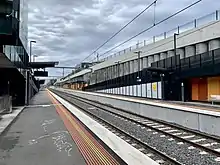
Metro Trains Melbourne are responsible for the day-to-day operations of 219 stations. Metropolitan railway stations include: terminus stations, premium stations staffed from first to last train (and all night during Night Network, except the underground city loop stations and Southern Cross stations, which close between 00.30–01:00) who provide extra assistance and information to commuters, and host stations that are staffed primarily between 07:00 to 9:30 for the morning peak, although some stations are staffed for an extended morning peak between 06:30 to 10:00.[27]
Ticketing
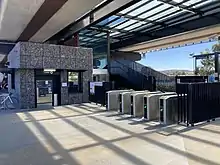
Metro Trains Melbourne uses the myki ticketing system exclusively. Myki is a time and zone based ticketing system, with validity periods ranging from two hours to one year, and two zones covering the Melbourne metropolitan area.
The Metcard ticketing system was decommissioned on 28 December 2012.[28][29][30]
Fare enforcement
Like the other modes of public transport in Victoria, Metro Trains Melbourne employs Authorised Officers (commonly known as "ticket inspectors") who exercise powers under the Transport (Compliance and Miscellaneous) Act 1983.[16] The main responsibilities of Authorised Officers are to report ticketing and behavioural offences to the Victorian Department of Transport, provide customer information and help during special events.
Authorised Officers are authorised by the Director of Public Transport to exercise powers similar to those of police, allowing them to check tickets and verify concession entitlements. In some circumstances, Authorised Officers may also perform arrests when aboard other vehicles operating under PTV or when on Department of Transport-owned premises, such as railway stations or train tracks.[31][32]
Authorised Officers are required to adhere to the Code of Conduct for Public Transport Authorised Officers.[33] and violations of this code are prosecuted. The Code of Conduct states that an Authorised Officer may use discretion when reporting an alleged offender, and must supply their name and work address when asked.[34] If an Authorised Officer believes that a passenger has committed an offence, they have the right to request the offender's name and address after having explained the nature of the alleged offence to the offender. The Authorised Officer also have the right to request proof of the given information. If the offender refuses to provide identification or provides false information, Authorised Officers will then contact Victoria Police. Authorised Officers also have the right to detain the offender until the police or further assistance arrives.[35]
Authorised Officers are required to submit a Report of non-compliance with the details, specific nature and circumstances of the offence to the Department of Transport, who then processes the reports and decide upon any penalties. Any fines levied are payable to the Department, not to Metro Trains Melbourne. Metro Trains Melbourne receives a small administration fee to cover the costs associated with employing Authorised Officers.[35]
Punctuality
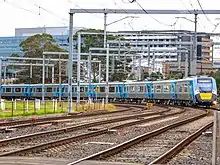
Metro failed to meet Government set targets for punctuality in all of its first 9 months in operation, with almost 1 in 4 trains being late.[36]
Metro's performance improved in 2011, exceeding performance benchmarks for six consecutive months from June to November – the first time this had been achieved since December 2008.[37][38] Since April 2012, the punctuality figures have been consistently outperforming the benchmark, while the delivery figures have either exceeded or were very close to the benchmark throughout 2012 and 2013.
Metro has been criticised for meeting its punctuality benchmarks by skipping stations, most commonly the City Loop.[39] In April 2012, Metro Trains acknowledged the practice of altering stopping condition of selected late-running trains (for example, stopping all station to express) in an attempt to make up lost time and meet the Operational Performance Regime set by the state government.[40][41] A ministerial document showed that the state government raised concerns that some station skipping may not have been warrented.[42] Reportedly, at least 129 drivers' incident reports from mid-April to May record services had been altered in the form of changing a stopping-all-stations to express or terminating a service early.[43] In June 2012, Metro was fined $2.7 million for January to March 2012 quarter for service performance, including skipping stations, running shorter services and bypassing City Loop stations.[44]
The seven-year 2017 contract renewal for Metro Trains contained tougher requirements for punctuality, larger fines for missing targets, and penalties for station skipping, short running and skipping the City Loop.[13][45] The operator was required to ensure 92% of trains ran on time rather than 88% under the previous contact, however the new contract still defined lateness as five minutes or more behind the timetable.[13] In the first month of the contract Metro Trains failed to hit the target, and a 2021 report found that the operator had not reduced cancellations significantly in the first three years.[46][47]
Metro met its 92% punctuality requirement for two years, until July 2022 when the operator was forced to give a day of free travel to some users after missing the target by 0.4% that month.[48] Large scale infrastructure projects such as Level Crossing Removal, and signalling upgrades have worked to improve the reliablility and punctuality of the network.
Legislation & governance
Transport Integration Act
The prime transport-related statute in Victoria is the Transport Integration Act 2010. The Act established the Department of Transport as the integration agency for Victoria's transport system. The Act also establishes and sets the charters of the State agencies charged with providing public transport rail services and managing network access for freight services, namely the Director of Public Transport and V/Line. The Act authorises the Director of Public Transport[49] to enter into contracts for the provision of transport services and this provision is the source of the power for the contract between Metro and the Director. In addition, the Transport Integration Act establishes VicTrack which owns the public rail network and associated infrastructure. VicTrack leases public transport land and infrastructure to the Director of Public Transport who leases it to transport operators such as Metro as well as entering into franchise agreements with the operators for them to run public transport services on behalf of the State.
Rail Safety Act
The safety of rail transport operations in Melbourne is regulated by the Rail Safety Act 2006 which applies to all commercial passenger operations.[50] The Act establishes a framework containing safety duties for all rail industry participants and requires operators who manage infrastructure and rolling stock to obtain accreditation prior to commencing operations. Accredited operators are also required to have a safety management system to guide their operations. Sanctions applying to the safety scheme established under the Rail Safety Act are contained in the Transport (Compliance and Miscellaneous) Act 1983.[51] The safety regulator for the rail system in Melbourne including trams is the Director, Transport Safety (trading as Transport Safety Victoria) whose office is established under the Transport Integration Act 2010. No blame investigations for rail matters are undertaken by the Chief Investigator, Transport Safety.
Ticketing and conduct
Ticketing requirements for trains, trams and buses in Melbourne are mainly contained in the Transport (Ticketing) Regulations 2006[52] and the Victorian Fares and Ticketing Manual.[53] Rules about safe and fair conduct on trains, trams and buses in Melbourne are generally contained in the Transport (Compliance and Miscellaneous) Act 1983[54] and the Transport (Conduct) Regulations 2005.[55]
Dumb Ways to Die
In November 2012, Metro launched the safety campaign Dumb Ways to Die which became a global viral video hit through sharing and social media. It also produced merchandise such as posters, stickers and badges.[56] The campaign was leaked to the public several days early by the Fake Metro Trains parody Twitter account.
In May 2013, Metro released a "Dumb Ways to Die" game as an app for iPhone, iPod touch iPad devices, and Android devices. The game invites players to avoid the dangerous activities engaged in by the various characters featured throughout the campaign. Within the app, players can also pledge to "not do dumb stuff around trains".[57] In November 2014, Metro released a sequel, "Dumb Ways to Die 2: the Games" which follows a similar premise as the first game in a style of various sporting events and also allows players to pledge.
References
- "Who we are". Metro Trains Melbourne. Archived from the original on 14 September 2017. Retrieved 14 September 2017.
- "Sydney Metro North West". MTR Corporation. Archived from the original on 30 March 2019. Retrieved 30 December 2017.
- "Who we are". Metro Trains Melbourne. Archived from the original on 14 September 2017. Retrieved 22 January 2019.
- "Ten things about London Underground, and lessons for Melbourne – Daniel Bowen dot com". www.danielbowen.com. 7 March 2018. Archived from the original on 26 September 2020. Retrieved 8 March 2018.
- "Metro Trains rated Australia's worst". The Age. 15 June 2011. Archived from the original on 11 November 2017. Retrieved 17 July 2015.
- Cooper, Mex (25 June 2009). "New train, tram operators for Melbourne". The Age. Archived from the original on 26 June 2009. Retrieved 14 January 2010.
- "Melbourne operators selected" Railway Gazette International August 2009 page 12
- Gardiner, Ashley (1 September 2009). "Melbourne's train system name changes from Connex to Metro". Herald Sun. Archived from the original on 8 September 2009. Retrieved 14 January 2010.
- "Union claims Metro taking shortcuts on safety". Herald Sun. 12 May 2012. Retrieved 16 May 2012.
- "Metro rip-off sees 100,000 commuters missing out of ticket compensation each month". Herald Sun. 14 July 2013. Archived from the original on 14 July 2013. Retrieved 15 July 2013.
- "Demand for compo after train chaos". Herald Sun. 13 July 2017. Retrieved 6 September 2017.
- "'Computer fault' sends Melbourne trains into meltdown". iTnews. Archived from the original on 18 January 2021. Retrieved 6 September 2017.
- Carey, Adam (12 September 2017). "Tough new conditions, fines for Metro Trains and Yarra Trams". The Age. Archived from the original on 7 May 2023. Retrieved 7 May 2023.
- Melbourne suburban rail operating contract awarded Archived 7 September 2020 at the Wayback Machine Railway Gazette International 12 September 2017
- UGL Melbourne Metro contract extended Rail Express 14 March 2023
- "Department of Transport: Who's who in Victoria's public transport network". Department of Transport, State Government of Victoria, Australia. Archived from the original on 23 May 2009. Retrieved 14 January 2010.
- Gardiner, Ashley (25 August 2009). "First of new trains arrives in Melbournec". Herald Sun. Archived from the original on 28 August 2009. Retrieved 14 January 2010.
- "VICSIG: Suburban Trains – X'Trapolis, accessed: 12 August 2009". Archived from the original on 11 May 2017. Retrieved 31 October 2009.
- "New $2 billion train deal to create 1000 local jobs". The Age. 12 September 2016. Archived from the original on 14 September 2016. Retrieved 12 September 2016.
- 1,100 Jobs with 65 New Trains Built in Victoria, For Victoria Archived 29 November 2017 at the Wayback Machine Premier of Victoria 12 September 2016
- Evolution Rail to supply Melbourne high capacity EMUs Archived 20 July 2018 at the Wayback Machine Railway Gazette International 12 September 2016
- "The state government is spending tens of millions of dollars to extend the life of Melbourne's oldest trains". 9 News Melbourne. 10 October 2017. Archived from the original on 20 March 2023. Retrieved 10 October 2017.
- https://www.heraldsun.com.au/news/victoria/order-for-highcapacity-trains-shows-airport-rail-link-on-track/news-story/c9af65d81b717a8dab8cb08fbee7211c
- "VICSIG – IEV100". vicsig.net. Archived from the original on 7 October 2021. Retrieved 7 October 2021.
- "EM class – vicrailways". www.vicrailways.com. Archived from the original on 7 October 2021. Retrieved 7 October 2021.
- Metro Trains Melbourne (August 2022). "WTT Network Configuration: Metro Rolling Stock". Archived from the original on 21 September 2022. Retrieved 27 September 2022.
- "Facts & figures". Department of Transport. 20 September 2011. Archived from the original on 6 January 2012. Retrieved 16 November 2011.
- "From Saturday 29 December, myki is the only way to go – Public Transport Victoria". Public Transport Victoria. 28 December 2012. Archived from the original on 9 January 2013. Retrieved 4 January 2013.
- "Fixing myki to get Victoria's transport ticketing system back on track". Office of the Premier of Victoria. 21 June 2011. Archived from the original on 8 December 2011. Retrieved 26 December 2011.
- "Metropolitan fares and tickets – Metlink – Your guide to public transport in Melbourne and Victoria". Metlink Melbourne. 20 December 2011. Archived from the original on 4 March 2012. Retrieved 26 December 2011.
- Department of Infrastructure: Authorised Officers Archived 20 May 2009 at the Library of Congress Web Archives
- "Authorised Officers – Metlink – Your guide to public transport in Melbourne and Victoria". Metlink Melbourne. 10 November 2011. Archived from the original on 11 October 2011. Retrieved 26 December 2011.
- "Authorised Officers". Department of Transport. 16 August 2011. Archived from the original on 10 January 2012. Retrieved 26 December 2011.
- Department of Infrastructure: Code of Conduct for Authorised Officers Archived 4 June 2009 at the Library of Congress Web Archives
- Metlink Melbourne: FAQs Archived 22 July 2008 at the Wayback Machine
- Lucas, Clay (31 May 2010). "Metro extends unbroken monthly record". The Age. Melbourne. Archived from the original on 9 April 2016. Retrieved 1 June 2010.
- "Performance on target, customer satisfaction up – Metro Trains Melbourne". metrotrains.com.au. 10 November 2011. Archived from the original on 18 November 2011. Retrieved 16 November 2011.
- "Performance on track – Metro Trains Melbourne". metrotrains.com.au. 9 December 2011. Archived from the original on 15 January 2012. Retrieved 11 December 2011.
- "Passengers left out of the Loop as Metro cuts corners to run trains on time". 30 June 2015. Archived from the original on 11 November 2020. Retrieved 3 September 2018.
- "Train drivers ordered to skip stations". Herald Sun. 19 April 2012. Archived from the original on 29 May 2014. Retrieved 16 May 2012.
- "Performance monitoring". Public Transport Victoria. 22 April 2012. Archived from the original on 7 July 2012. Retrieved 17 May 2012.
- "State Government concerned Metro is skipping stations at passengers expense to hit targets". Herald Sun. 16 April 2012. Retrieved 16 April 2012.
- "Trains skip stations to evade fines". The Age. 25 May 2012. Archived from the original on 6 September 2017. Retrieved 25 May 2012.
- "Skipping stations adds to Metro's record fine". The Age. 19 June 2012. Archived from the original on 21 June 2012. Retrieved 19 June 2012.
- "Putting People First: A Better Deal For Passengers | Premier of Victoria". www.premier.vic.gov.au. Archived from the original on 8 May 2023. Retrieved 7 May 2023.
- Jacks, Timna (12 January 2018). "Metro Trains and Yarra Trams fail to meet tough new standards". The Age. Archived from the original on 7 May 2023. Retrieved 7 May 2023.
- Jacks, Timna (18 February 2021). "Metro Trains fails to deliver on promise after scoring $6.3b contract". The Age. Archived from the original on 7 May 2023. Retrieved 7 May 2023.
- Eddie, Rachel (16 August 2022). "Metro's poor performance leads to refunds, but only for some". The Age. Archived from the original on 7 May 2023. Retrieved 7 May 2023.
- Transport Integration Act, section 68(1)(b).
- Official copy of the Rail Safety Act from the Victorian Government legislation web site – http://www.legislation.vic.gov.au/Domino/Web_Notes/LDMS/LTObject_Store/LTObjSt3.nsf/DDE300B846EED9C7CA257616000A3571/6D4190C62DE6207FCA257761002C568A/$FILE/06-9a016.pdf Archived 6 July 2011 at the Wayback Machine
- See Part 7 of the Act. Official copy of the Transport (Compliance and Miscellaneous) Act 1983 from the official Victorian Government legislation site – http://www.legislation.vic.gov.au/Domino/Web_Notes/LDMS/LTObject_Store/LTObjSt5.nsf/DDE300B846EED9C7CA257616000A3571/7BB774D3E0245B77CA2577CE00030B90/$FILE/83-9921a153.pdf Archived 17 March 2011 at the Wayback Machine
- "Transport (Ticketing) Regulations 2006" (PDF). Archived (PDF) from the original on 7 March 2012. Retrieved 18 November 2010.
- Victorian Fares and Ticketing Manual – Metlink – Your guide to public transport in Melbourne and Victoria Archived 14 May 2011 at the Wayback Machine
- "Victorian Law Today Act". Archived from the original on 7 March 2012. Retrieved 18 November 2010.
- "Victorian Law Today Statutory Rule". Archived from the original on 20 September 2011. Retrieved 18 November 2010.
- "Metro's tongue-in-cheek transport safety animated video goes viral on social media". The Age. 19 November 2012. Archived from the original on 19 January 2018. Retrieved 19 November 2012.
- Dumb Ways to Die Is Now a Video Game for the iPhone and iPad Archived 17 October 2018 at the Wayback Machine, Adweek, 17 May 2013